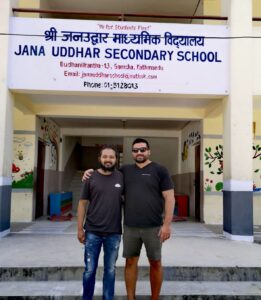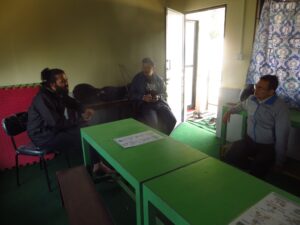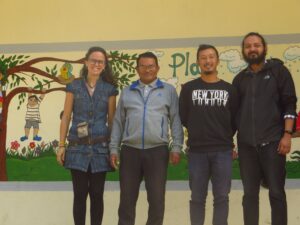The story of Code Chautari: How it all started
May 18.
Berta, Shisir and Amrit are in the Teach for Nepal office, discussing a possible program/project collaboration to provide IT education (particularly programming skills) for free to children from poor and marginalized backgrounds .
Berta Navarro Peró (fondly known as Berta kanchhi), originally from Spain spent five years of her life in Nepal involved in various social projects. Later she founded InspireU Adventures, a trekking and tours organization business based in Spain. Previously she worked as an event organizer for about 10 years. And her little secret, she is also a jewelry designer and artisan and makes beautiful pieces with macramé, gems, stones, and crystals: BeArt.Berta.
Shisir Khanal is a serial entrepreneur who has co-founded multiple ventures. He is the co-founder of Sarvodaya Nepal, Teach for Nepal, Pick N Drop Nepal and Nitishala Nepal. Currently, he is the CEO of Nitishala Nepal and also an Education Advisor at Tulsipur Sub Metropolitan City, Nepal.
Amrit Puri is a Teach for Nepal alumnus and was formerly a Teach for Nepal Science teaching fellow. He previously worked as a software engineer at CloudFactory before joining TFN. He also has experience in leading a team of content designers at Karkhana that designed STEAM integrated classroom activities.
Jakob Bradford (General Manager of the NDC Conferences) and his team were collaborating in different social programs for many years. NDC Conferences is an international conference that gathers professionals and the best minds in the programming industry to share knowledge and grow together. So this time they wanted to create a social program related to the programming field as well. Jakob and his team’s dream was to help children in Nepal to offer an exposure to a professional path in programming and build related skills. It’s when Jakob expressed this desire to Berta.


So, Berta was looking for a possible collaborator or an advisor who had a very sound understanding of the education system in Nepal and working in the education field itself. And that’s when Shisir was introduced to Berta. Shisir was the CEO of Teach for Nepal which was a very reputed and well established non-profit organization in the field of education. Shisir himself co-founded TFN and thus had all the technical and social knowledge of Nepal’s education system.
Amrit was introduced to Berta by Shisir later because Amrit had experience in both programming and as a teacher. Amrit was himself interested in computer and programming skills to more kids who might never get the privilege. And that’s how different paths crossed to initiate the collaboration.
Initially, we had discussions on ‘what needs to be done’ to support students in public schools regarding computer literacy and ‘what can be done’. We came up with a few ideas and plans. One of them was starting a full fledged residential IT institute which would take fresh SEE graduates from public schools of Nepal, train them, prepare them for internships and jobs in IT companies.
Yes, we dreamt big. We loved our big dream and were very excited about it. We hope we can someday do that too. Discussing more and funneling down on the feasible ideas, we settled on the idea of an after school program that would be piloted in a public school in Kathmandu itself.
Things slowly started to come into place. The next step was to formulate this idea into a concrete plan. We need to come up with budget estimations, curriculum designs, lesson plans, school selection, students selection etc. We also began our informal research on the impact of coding classes for kids in other countries and how other schools/institutes/teachers do coding classes/workshops. We wanted to take ideas and contextualize them into our classes here in Nepal. We also discussed more to niche down on what we wanted in our curriculum among the vast possibilities of Digital Literacy, Computer Literacy and Programming.
In November, 2018 Berta, Shisir and Amrit officially decided to take the program forward and develop a year-long curriculum. Amrit took the lead. We started formalizing the program support in funds from NDC Conferences. Jakob (the GM of NDC Conferences), Berta and Amrit had a series of discussions regarding the collaboration. Jakob was equally excited that NDC and all the speakers at NDC’s events were contributing in providing less privileged kids with a universal skill set of computer and coding thereby giving them a lifeline out of poverty.
Based on our discussions, we had this idea to include someone who had already worked as a programming educator in schools or colleges. And that’s how Sheetal joined us in our journey.
Sheetal has a Masters in Computer Science from Mysore University, Karnataka. He is currently working as a Senior IT officer at Nepal Federation of Saving and Credit Cooperative Unions Ltd. Previously, he was a lecturer at Amrit Campus. Sheetal has 4 years of experience in teaching programming to school kids and 4 years with undergraduate and graduate students.
Sheetal and Amrit together came up with our own curriculum and full fledged lesson plans of each class. One of the basic ideas in the curriculum was to make the kids computer literate – make them able to use basic computer tools that would help them in enriching their learning in the school currently and also help them in their higher studies and prospective career. The next idea was to develop computational thinking and 21st century skills (Collaboration, Communication, Critical Thinking and Creativity) through our integrated classes on programming.
We wanted the kids to have basic ideas of programming concepts. We wanted them to dive into the world of fun in coding and see if they would be interested to pursue it as a career. We wanted them to develop the computational thinking and problem solving mindset in a subtle way so that they could use this skill in any field to solve any problems they would come across.
The programming in our curriculum would include Scratch, a visual block-based programming platform developed by Lifelong Kindergarten Group at the MIT Media Lab and is provided free of charge. Scratch could be used to program interactive stories, games, and animations. It is such a well thought out platform for kids but still powerful enough to develop programming concepts. And when kids would get used to code and think in codes, they would be introduced to Python. They would dive into the basics of Python syntax to understand how an actual text-based programming looked and felt like.
When we were ready with our curriculum, we needed a school who would be equally excited to adopt our program and a person who could deliver these in the classes. Amrit came on board again and decided to continue with the project. He would lead the project and also deliver the classes in the school.

Amrit met with Rajan, who is a Co-Director at CSN adopts and manages public schools in Nepal. Rajan also happens to be a TFN alumnus. Rajan introduced us to Mr. Hareram Khatrai, the principal of Jana Uddhar Secondary School, a public school in Gamcha, Budhanilakantha, Nepal. Mr. Hareram was very excited to collaborate with us and provide this opportunity to the kids studying there. And thus, Jana Uddhar Secondary School became our implementation partner.

But we still hadn’t come up with a name for the program yet. We wanted a name that would coincide with our initial vision related to programming. We also wanted to have some connection to itself. The first word that clicked quite well was ‘code’ referring to programming in our context. We came up with few names like Code Karyashala (Karyashala means workshop in Nepali), Code Shala (Shala is a Sanskrit word meaning, “home, abode”.), Code Chautari (Chautari is a rest stop usually found along the foot trails of rural Nepal.) and few others.
The word Chautari connected very well to Berta, Jakob and Amrit. Chautari has a very authentic and deep rooted value for trekkers, villagers, seniors and almost any Nepali person. Chautari is a place where people rest, where people have community discussions, where retired seniors play Baagh-Chaal, a board game that is a little like checkers.
When we began developing the ideas and plans around our programming project, we wanted it to be a space of learning and a space of fun-filled activities. The world Chautari felt quite in alignment with that space we dreamt about. So we decided on Code Chautari as the formal name.
And that’s how Code Chautari started.
This has been possible due to continuous support from NDC Conferences and all its speakers coordinated by Jakob, Berta who has been the source of energy and commitment for Code Chautari and Shisir, who has been a mentor throughout the journey, Mr. Hareram Khatri and Jana Uddhar Secondary School who gave us the portal to our journey and all our participating kids who give us the energy and excitement every single day.
